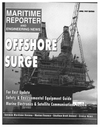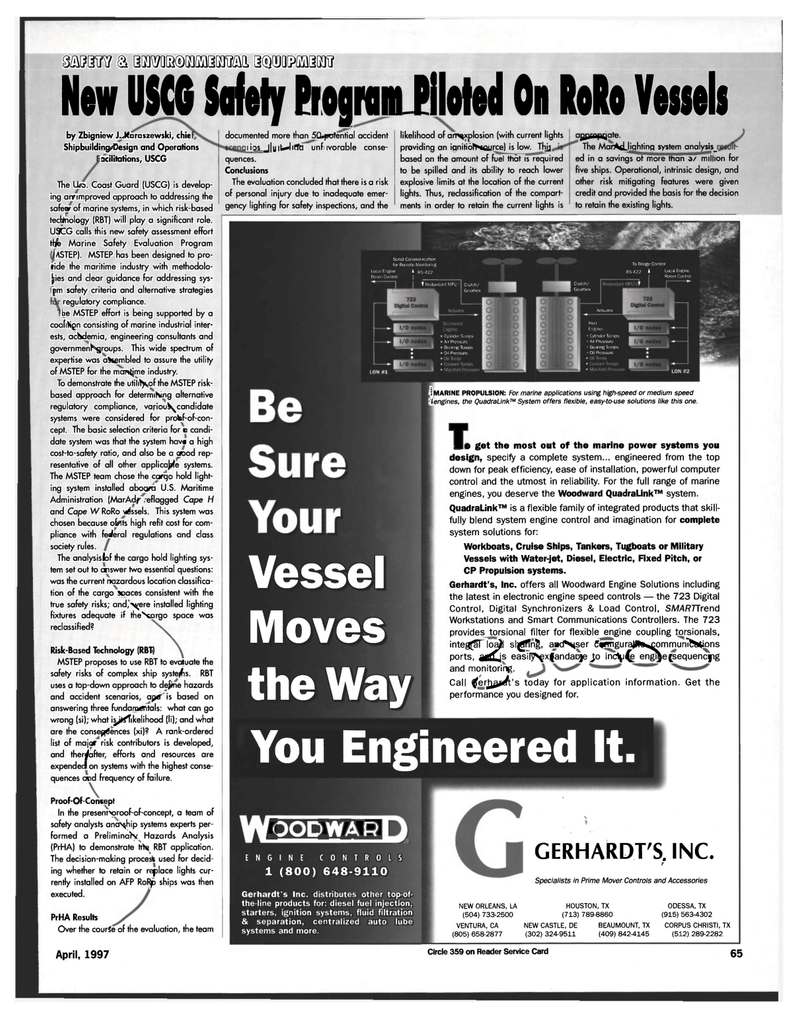
Page 65: of Maritime Reporter Magazine (April 1997)
Read this page in Pdf, Flash or Html5 edition of April 1997 Maritime Reporter Magazine
Serial Communication for Remote Monitoring
Local Engine A RS-422
Room Control
To Bridge Control
RS-422 • Local Engine
Room Control
Clutch/
Gearbox
Redundant MPU'; Clutch/
Gearbox
Actuator
Port
Engine: • Cylinder Temps > Air Pressure • Bearing Temps > Oil Pressure
Cylinder Temps
Air Pressure
Bearing Temps
Oil Pressure mmm & nswwa BMP^M
New USCG Safety Program Piloted On RoRo Vessels by Zbigniew J. Karaszewski, chie
Shipbuilding Design and Operations acilitations, USCG
The lira. Coast Guard (USCG) is develop- ing anrimproved approach to addressing the safew of marine systems, in which risk-based technology (RBT) will play a significant role.
USCG calls this new safety assessment effort thfe Marine Safety Evaluation Program
ASTEP). MSTEP has been designed to pro- fide the maritime industry with methodolo- gies and clear guidance for addressing sys- fm safety criteria and alternative strategies regulatory compliance, he MSTEP effort is being supported by a coafitipn consisting of marine industrial inter- ests, acidemia, engineering consultants and governmenSgroups. This wide spectrum of expertise was assembled to assure the utility of MSTEP for the mOTttjme industry.
To demonstrate the utilifysof the MSTEP risk- based approach for deternmKmg alternative regulatory compliance, variou^candidate systems were considered for protsf-of-con- cept. The basic selection criteria for e candi- date system was that the system hava a high cost-to-safety ratio, and also be a aood rep- resentative of all other applicajjrte systems.
The MSTEP team chose the carcjo hold light- ing system installed aboaro U.S. Maritime
Administration (MarAdf-eflagged Cape H and Cape W RoRo vessels. This system was chosen because o£flts high refit cost for com- pliance with federal regulations and class society rules.
The analysislof the cargo hold lighting sys- tem set out to answer two essential questions: was the current nazardous location classifica- tion of the cargo Soaces consistent with the true safety risks; and/^ere installed lighting fixtures adequate if theNxirgo space was reclassified?
Risk-Based Technology (RBT)
MSTEP proposes to use RBT to evaluate the safety risks of complex ship systems. RBT uses a top-down approach to define hazards and accident scenarios, aj>«r is based on answering three fundamentals: what can go wrong (si); what i^i^ikelihood (li); and what are the consequences (xi)? A rank-ordered list of major risk contributors is developed, and thereafter, efforts and resources are expended on systems with the highest conse- quences OTid frequency of failure.
Proof-Of-Concept
In the presennoroof-of-concept, a team of safety analysts anas^hip systems experts per- formed a Preliminary Hazards Analysis (PrHA) to demonstrate trVs RBT application.
The decision-making procesi used for decid- ing whether to retain or replace lights cur- rently installed on AFP RoRp ships was then executed.
PrHA Results
Over the courSe of the evaluation, the team documented more than 50 potential accident lii llnil lirfn nnfii ml I conse- quences.
Conclusions
The evaluation concluded that there is a risk of personal injury due to inadequate emer- gency lighting for safety inspections, and the likelihood of am^xplosion (with current lights providing an ignitiotKaurce) is low. Thjj based on the amount of fuel that is required to be spilled and its ability to reach lower explosive limits at the location of the current lights. Thus, reclassification of the compart- ments in order to retain the current lights is agjawpqate.
The Man^tLlighting system analysis^ ed in a savings of more than million for five ships. Operational, intrinsic design, and other risk mitigating features were given credit and provided the basis for the decision to retain the existing lights.
I MARINE PROPULSION: For marine applications using high-speed or medium speed tengines, the QuadraLink™ System offers flexible, easy-to-use solutions like this one.
T
Vessel
Moves the Way
You Engineered It
I o get the most out of the marine power systems you design, specify a complete system... engineered from the top down for peak efficiency, ease of installation, powerful computer control and the utmost in reliability. For the full range of marine engines, you deserve the Woodward QuadraLink™ system.
QuadraLink™ is a flexible family of integrated products that skill- fully blend system engine control and imagination for complete system solutions for:
Workboats, Cruise Ships, Tankers, Tugboats or Military
Vessels with Water-jet, Diesel, Electric, Fixed Pitch, or
CP Propulsion systems.
Gerhardt's, Inc. offers all Woodward Engine Solutions including the latest in electronic engine speed controls — the 723 Digital
Control, Digital Synchronizers & Load Control, SMARTJrenti
Workstations and Smart Communications Controllers. The 723 provides torsional filter for flexible engine coupling torsionals, integf^T loa^l sl^ffnt, aad^ser Cqmgura||N^^mmuni&S*k>ns ports, atfCjs easil^xfandaqe Jo incl^^ engfyepequencjig and monitoring.
Call fferj^/t's today for application information. Get the performance you designed for.
L 5 I S3
ENGINE CONTROLS 1 (800) 648-9110
Gerhardt's Inc. distributes other top-of- the-line products for: diesel fuel injection, starters, ignition systems, fluid filtration & separation, centralized auto lube systems and more.
GERHARDT'S. INC.
Specialists in Prime Mover Controls and Accessories
NEW ORLEANS, LA (504) 733-2500
VENTURA, CA (805) 658-2877
HOUSTON, TX (713) 789-8860
NEW CASTLE, DE BEAUMOUNT, TX (302) 324-9511 (409) 842-4145
ODESSA, TX (915) 563-4302
CORPUS CHRISTI, TX (512) 289-2282
April, 1997 Circle 359 on Reader Service Card 65

 64
64

 66
66
